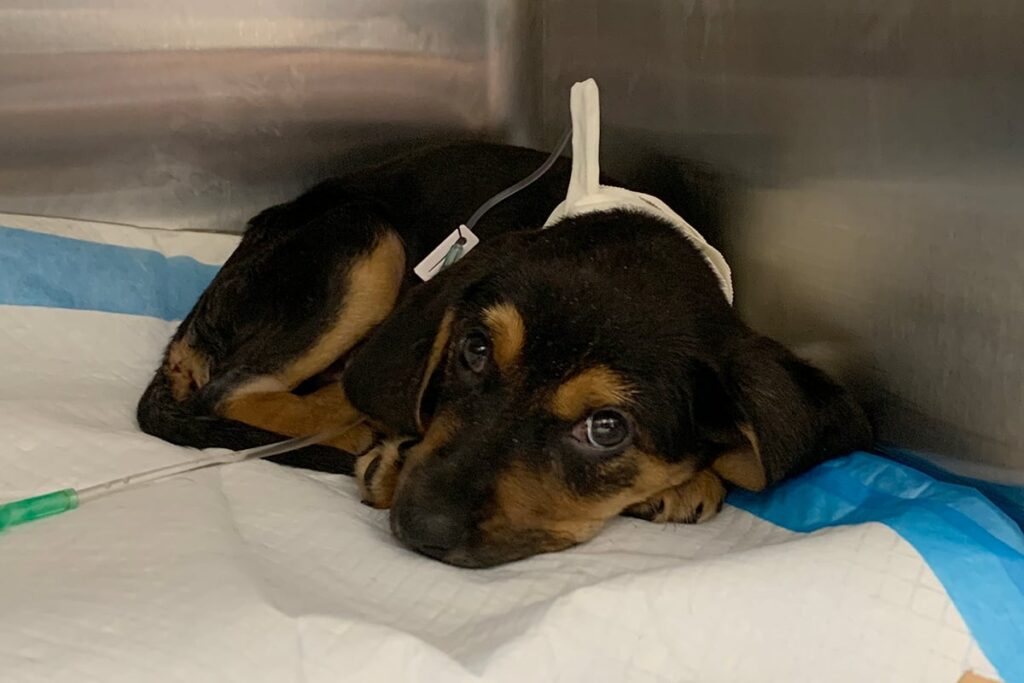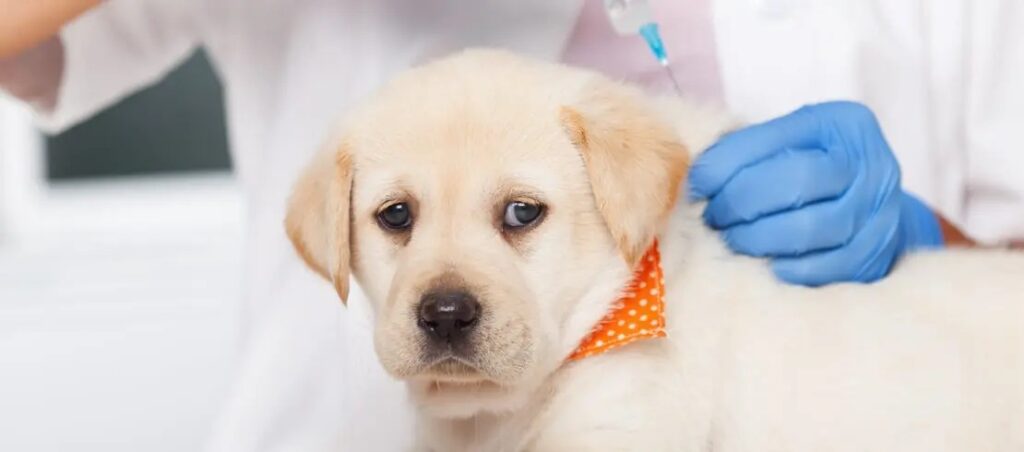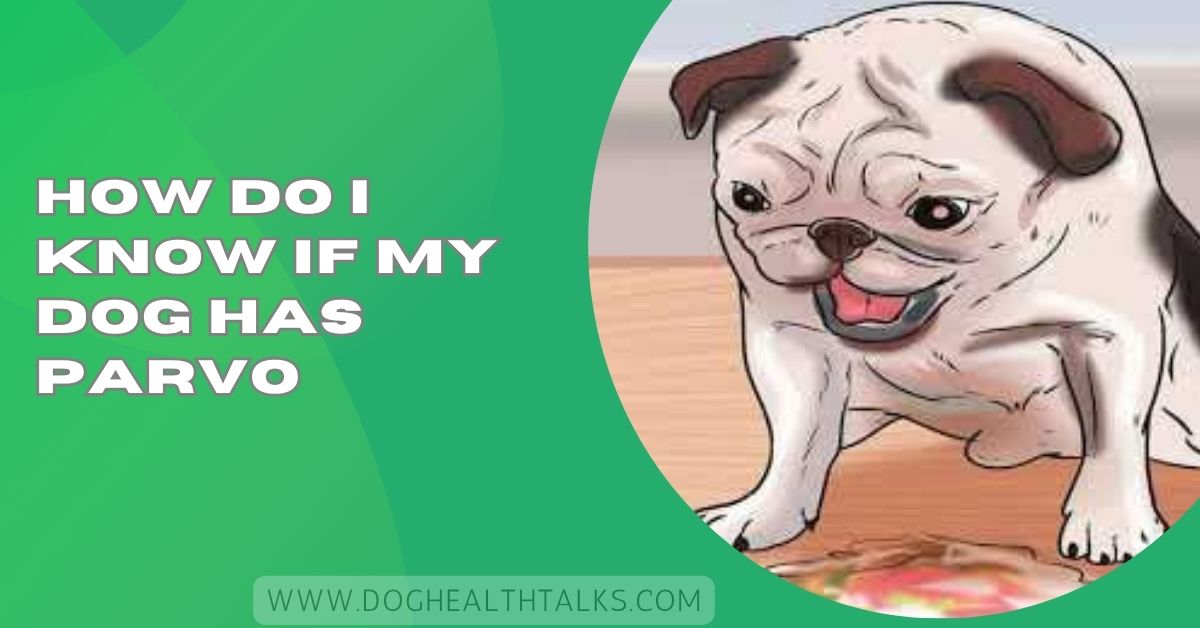If your dog suddenly seems tired, stops eating, or begins vomiting, it might make you wonder — could it be parvo?
You can tell if your dog has parvo by signs like extreme lethargy, loss of appetite, fever, vomiting, and foul-smelling or bloody diarrhea. Immediate veterinary care is essential for diagnosis and treatment.
This guide will help you recognize the warning symptoms, understand how it spreads, and know exactly when to call your vet.
Canine Parvovirus (CPV) is a highly contagious virus that attacks a dog’s gastrointestinal system and immune cells. It mainly affects unvaccinated dogs and puppies under six months old, though adult dogs can also catch it if their immunity is low.
Parvo destroys the cells lining the intestines, causing severe vomiting, diarrhea, and dehydration. In young puppies, it can also attack the heart, leading to sudden death. The virus is tough — it can survive on surfaces, soil, or dog toys for months, even after cleaning.
In short: Parvo spreads easily, kills quickly, and demands immediate action.

Dogs catch parvo through the fecal-oral route, meaning they come into contact with the virus through infected poop or contaminated surfaces. Even a tiny trace of infected stool on the ground, shoes, or fur can spread the virus. It can live in:
- Dog parks and kennels
- Grooming tables and vet clinics
- Crates, bedding, bowls, and carpets
Puppies often catch it after sniffing or licking contaminated areas outdoors. Since parvo can live for months in the environment, even indirect exposure (like on your shoes) can infect your dog.
Risk factors include:
- Not being vaccinated
- Visiting crowded dog areas
- Weak immune system (especially in young puppies)
Also Read: Dog Lap Day Calculator – Discover Your Dog’s Age Match Day!
After exposure, parvo incubates silently inside the body for about 3 to 7 days. During this time, your dog may appear completely normal while the virus multiplies inside the intestines and lymph nodes.
Once symptoms begin, they often worsen very quickly — sometimes within hours. That’s why early awareness is critical.
The first signs of parvo can be subtle. At first, your dog might just seem “off” — a bit tired or less hungry than usual. But within a day or two, more serious symptoms appear.
Common early signs include:
- Lethargy: Your dog sleeps more or shows no interest in playing.
- Loss of appetite: Even favorite treats are ignored.
- Fever or low temperature: Parvo disrupts the immune system, causing temperature swings.
- Vomiting: Starts mildly but soon becomes frequent and uncontrollable.
- Diarrhea: Often watery and later bloody, with a foul smell.
- Dehydration: Dry gums, sunken eyes, or sticky saliva.
If your puppy has vomiting and bloody diarrhea at the same time, consider it a medical emergency. This is the hallmark of parvo.
When left untreated, parvo escalates quickly into a life-threatening condition. Dogs can lose fluids and electrolytes rapidly, leading to shock and organ failure.
Severe symptoms include:
- Continuous vomiting and bloody diarrhea
- Extreme weakness or collapse
- Pale or grayish gums
- Rapid heart rate and breathing difficulty
- Hypothermia (low body temperature)
At this stage, your dog’s body is fighting to survive. Immediate veterinary attention is the only way to save them.

Many illnesses cause similar symptoms — that’s why only testing can confirm parvo.
Conditions that can mimic parvo include:
- Intestinal parasites (worms, giardia)
- Food poisoning or garbage ingestion
- Pancreatitis (inflammation of the pancreas)
- Distemper virus
- Bacterial infections (like Salmonella)
If your dog has vomiting and diarrhea, do not assume it’s “just something they ate.” A vet exam and diagnostic test are essential to confirm whether it’s parvo or something else.
When you take your dog to the vet, they’ll perform a few quick tests to confirm parvo.
1. Fecal ELISA or SNAP Test
This is the most common test — it detects the virus in your dog’s stool. It takes just 10–15 minutes to show results.
2. PCR Test
If the ELISA test is inconclusive, your vet might run a PCR test, which identifies parvo DNA. It’s more accurate but takes longer.
3. Blood Tests
Vets also check for low white blood cell counts (a sign of viral infection) and dehydration levels.
Cost Range: Testing usually costs between $40 and $150, depending on your location and clinic.
Early testing not only confirms the diagnosis but also increases your dog’s chances of survival through faster treatment.
Must Read: Why Do Dogs Chew Their Nails: Comprehensive Guide In 2025!
There’s no direct cure for parvo — treatment focuses on supportive care to keep the dog alive while their immune system fights off the virus.
Typical hospital treatment includes:
- IV fluids: Rehydrate and restore electrolytes.
- Antiemetic drugs: Control vomiting and nausea.
- Antibiotics: Prevent secondary bacterial infections.
- Nutritional support: Specialized diets or feeding tubes to maintain strength.
- Close monitoring: Round-the-clock care in isolation to prevent spreading the virus.
Most dogs need 3 to 7 days in hospital care. With proper treatment, up to 90% of dogs can survive parvo.
💡 Tip: Never try to treat parvo at home without a vet’s guidance. Home remedies can’t replace professional fluid therapy.
Once your dog survives the first few critical days, recovery gradually begins. Appetite improves, vomiting stops, and stool becomes firmer.
Average recovery time: 10–14 days.
Survival rate with treatment: 80–90%.
Without treatment: Survival drops below 10%.
After recovery:
- Keep your dog isolated for at least 2 weeks, as they may still shed the virus.
- Provide bland food (boiled chicken, rice) to ease digestion.
- Clean and disinfect all bedding, bowls, and floors using a bleach solution (1:30).
Some dogs might have sensitive stomachs for a few months after parvo, but most make a full recovery.

Call your vet or an emergency clinic right away if your dog shows any combination of the following:
- Persistent vomiting
- Bloody or foul-smelling diarrhea
- Extreme tiredness or weakness
- Refusing to eat or drink
- Sudden weight loss
- Pale gums or cold paws
Even if you’re unsure, it’s always better to act fast. Parvo can kill within 48–72 hours if left untreated.
Before you reach the vet:
- Keep your dog warm and calm.
- Offer small sips of water if possible.
- Avoid contact with other pets.
The best defense against parvo is vaccination. It’s part of the standard “core” puppy vaccines and protects against multiple deadly diseases.
| Puppy Age | Vaccine Action |
| 6–8 weeks | First parvo shot |
| 10–12 weeks | Second booster |
| 14–16 weeks | Final booster |
| 1 year | Annual booster |
After that, adult dogs usually need a booster every 1–3 years.
- Use bleach solution (1:30) to disinfect surfaces.
- Wash dog bedding, bowls, and toys separately.
- Keep unvaccinated dogs away from dog parks and shelters.
Remember, the virus can survive for months — clean thoroughly and limit exposure until your puppy is fully vaccinated.
Read Out: Can Dogs Drink Gatorade? Owner’s Guide: Safe or Not!
Once your vet clears your dog to go home, follow these recovery tips:
- Feed small meals of bland food (boiled chicken, rice, or vet-recommended diets).
- Keep your dog warm — parvo dogs often struggle to regulate temperature.
- Hydrate — use vet-approved electrolyte solutions.
- Rest is vital — avoid exercise or play until energy returns.
- Track progress — monitor stool, appetite, and energy daily.
Give love, patience, and comfort. Recovery can be slow, but your care makes all the difference.
At home, you may notice your dog becoming weak, not eating, vomiting, or having bloody diarrhea. Their stool may smell foul, and they might stop drinking water. If you see these signs, call a vet immediately.
Early parvo signs include tiredness, loss of appetite, mild fever, and vomiting. Your dog may seem sad, weak, and uninterested in playing. Within a day, diarrhea often starts, which quickly becomes severe and dangerous.
Parvo starts with tiredness and no appetite on day one. By day two or three, vomiting and diarrhea begin. Around day four, dogs become dehydrated, weak, and may collapse. Without treatment, parvo worsens quickly and can be fatal.
In the last stages, puppies become too weak to stand, refuse food and water, and have continuous vomiting and bloody diarrhea. Their gums turn pale, body temperature drops, and they may go into shock or collapse suddenly.
Dogs get parvo by touching infected poop, soil, or objects like bowls or toys. The virus spreads easily through shoes, clothes, or other dogs. Unvaccinated puppies are most at risk, especially in public places or shelters.
Recovery signs include your dog eating again, stopping vomiting, and having normal stool. Their energy slowly returns, and they start drinking water willingly. With proper care, appetite and playfulness usually return within one to two weeks.
Treatment includes hospital care, IV fluids, and medicine to stop vomiting and prevent infections. Dogs need warmth, nutrition, and round-the-clock monitoring. With quick vet care, most dogs recover well and gain strength back within a few days.
The first parvo symptoms include tiredness, loss of appetite, vomiting, and mild fever. Your dog may seem weak and less playful than usual.
Parvo poop is watery, often dark brown or bloody, and has a strong, foul smell. It may contain mucus and appear sticky.
The first stage starts with weakness, no appetite, fever, and vomiting. Your dog might seem sad and tired before diarrhea begins suddenly.
No, parvo never goes away on its own. Without fast veterinary treatment, the virus can quickly become deadly for puppies and unvaccinated dogs.
Other illnesses like worms, food poisoning, pancreatitis, or bacterial infections can look like parvo since they also cause vomiting and diarrhea.
Puppies between six weeks and six months old are most at risk for parvo, especially if they aren’t fully vaccinated yet.
Parvo vomit is often yellow, clear, or brown and may contain foam. It becomes bloody as the infection gets worse.
The fastest cure is immediate vet care with IV fluids, anti-vomiting medicine, and antibiotics. Early treatment gives the best chance of survival.
Parvo treatment usually costs between $500 and $2,000, depending on severity, hospital stay, and the care your dog needs.
Parvo has a strong, rotten, metallic smell caused by bloody diarrhea. It’s very unpleasant and often one of the earliest warning signs.
Parvo is one of the most dangerous viruses a dog can face, but early action can save your pet’s life. If your dog shows signs like vomiting, loss of appetite, or bloody diarrhea, don’t wait — contact a vet immediately. Quick testing and proper treatment can make the difference between recovery and tragedy.
Preventing parvo is always easier than treating it. Keep your dog’s vaccinations up to date, avoid exposing young puppies to unknown dogs or public areas, and disinfect their environment regularly.
With love, care, and awareness, you can protect your furry friend from this deadly virus and ensure they live a long, healthy, and happy life.
